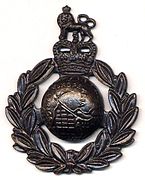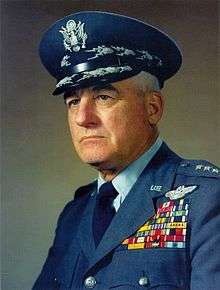Cap badge
A cap badge, also known as head badge or hat badge, is a badge worn on uniform headgear and distinguishes the wearer's nationality and/or organisation. The wearing of cap badges is a convention commonly found among military and police forces, as well as uniformed civilian groups such as the Boy Scouts, civil defence organisations, ambulance services (e.g. the St. John Ambulance Brigade), customs services, fire services etc.

Cap badges are a modern form of heraldry and their design generally incorporates highly symbolic devices.
British armed forces
In the British Army (as well as Commonwealth armies) each regiment and corps has its own cap badge. The cap badge of the Queen's Royal Lancers is called a motto by those within the regiment,[1] that of the Royal Horse Artillery is known as a cypher and that of the Coldstream Guards, Scots Guards and Irish Guards is known as a Capstar. That of the Grenadier Guards is known as The Grenade Fired Proper
The concept of regimental badges appears to have originated with the British Army. The Encyclopædia Britannica's 1911 Edition notes that although branch badges for infantry, cavalry and so on were common to other armies of the time, only the British Army wore distinctive regimental devices.[2]
Cap badge variations
Plastic cap badges were introduced during the Second World War, when metals became strategic materials. Nowadays many cap badges in the British Army are made of a material called "stay-brite" (anodised aluminium, anodising is an electro-plating process resulting in lightweight shiny badge), this is used because it is cheap, flexible and does not require as much maintenance as brass badges.
Regimental cap badges are usually cast as one single piece but in a number of cases they may be cast in different pieces. For instance, the badge of the now amalgamated, The Highlanders (Seaforth, Gordons and Camerons) was cast in two separate pieces: the Queen's Crown and the thistle forming one piece, and the stag's head and scroll with regimental motto forming a second piece (see the first picture above).
The Royal Corps Of Signals also have a two part badge. The top being a brass crown and the bottom consisting of a silver flying body of Mercury (the winged messenger of the gods – 'Jimmy') above a brass world and the motto Certa Cito (Swift and Sure).
A regiment or battalion may maintain variations of the same cap badge for different ranks. These variations are usually in the badges' material, size and stylization. Variations in cap badges are normally made for:
- Officers: usually three-dimensional in design with more expensive materials such as silver, enamel and gilt. Most officers' beret badges are embroidered rather than metal or "stay-brite".
- Senior Non-Commissioned Officers such as sergeants, Colour Sergeants and Warrant Officers: a more elaborate design compared with those worn by other ranks but usually not as elaborate as those worn by officers.
There are exceptions such as the Welsh Guards, where all ranks wear a cloth cap badge. Officers wearing a more elaborate version to that of soldiers, made using gold thread and has a more three-dimensional design. The only exception to this is recruits in training who have to wear the brass (or more often "stay-brite") leek, often referred to as the "NAAFI fork", only until they have passed out of training and reached their battalion will they receive their cloth leek. All ranks of the Special Air Service wear an embroidered capbadge and all ranks of The Rifles and Royal Regiment of Fusiliers wear the same metal badge.
Some regiments maintain a blackened or subdued version of their cap badges as shiny brass cap badges may attract the enemy's attention on the battlefield. However, since the practice of British soldiers operating in theatre with regimental headdress (i.e. peaked cap, beret) has all but died out, the wearing of these has become much less common in recent years.
Wearing conventions
The cap badge is positioned differently depending on the form of headdress:
- Service dress cap: above the centre point between the wearer's eyebrows
- Beret: above the left eye[3]
- Side cap: Between the left eye and the left ear
- Scottish tam o'shanter: Between the left eye and the left ear
- Scottish glengarry: Between the left eye and the left ear
- Feather Bonnet: Slightly off the left ear towards the left eye
- Fusilier cap or Busby: Slightly off the left ear towards the left eye
- Jungle hat (as worn by the Brigade of Gurkhas in Number 2 dress): Centre front or between left eye and left ear.
Soldiers of the Gloucestershire Regiment and subsequently the Royal Gloucestershire, Berkshire and Wiltshire Regiment wore a cap badge on both the front and the rear of their headdress, a tradition maintained by soldiers in The Rifles when in service dress. The back badge is unique in the British Army and was awarded to the 28th Regiment of Foot for their actions at the Battle of Alexandria in 1801.
Additional items that reflect a regiment's historical accomplishments, such as backing cloth and hackles, may be worn behind the cap badge. In Scottish regiments, for instance, it is a tradition for soldiers to wear their cap badges on a small square piece of their regimental tartans. Officer Cadets may wear a small white backing behind their badges. Members of arms such as the Adjutant General's Corps and Royal Electrical and Mechanical Engineers serving on attachment to other units often wear that regiment's beret or headdress but with their own Corps cap badge.
For a period leading up to Remembrance Day artificial poppies are worn by many people in the United Kingdom and Canada to commemorate those killed in war. When worn in uniform the plastic stem of the poppy is discarded and the paper petals are fitted behind the beret badge where a metal cap badge is worn. On forage caps the paper petals are fitted under the left hand chin strap button.
Royal Marines
In the Royal Marines, cap badges are worn on peaked caps and berets. Those of commissioned officers are split in two, the crown and lion atop, but separated from, the globe and laurels. In the Royal Marines Band Service, the Portsmouth band and CTCRM band have different cap badges from the rest of the Corps.[4][5]
 Cap badge of officers.
Cap badge of officers.
 Cap badge of officers.
Cap badge of officers.
Royal Navy
Cap badges in the Royal Navy differ between ranks but have some common features: junior rates (Able Seaman to Leading Seaman do not wear cap badges, wearing the peakless sailor's cap in number one dress. When wearing a beret, junior ratings will wear a fouled anchor within a gold ring as a beret badge. Petty Officers wear a silver fouled anchor within a gold circle, with St Edward's Crown above the ring as their cap badge. That of Chief Petty Officers is the same, but with a small laurel wreath around the gold ring. That of warrant officers (both Class I and Class II) has a larger wreath around the anchor, but omits the ring. The laurel wreath around that of commissioned officers is larger still.
 Cap badge of a junior rating, worn on a beret.
Cap badge of a junior rating, worn on a beret.
Canadian Armed Forces
The Canadian Armed Forces utilize a variety of metal and cloth cap badges on their headdress, and many follow British traditions for additions such as cloth behind, blackened metal badges for rifle regiments, etc. Distinct cap badges identify service members' personnel branch or, in the case of infantry and armoured soldiers, regimental affiliation. Some units further differentiate NCMs from officers by cap badge material (for example: Artillery officers wear gold-wire embroidered cloth instead of brass, Lord Strathcona's Horse officers wear silver rather than brass).
United States

U.S. Army
In the United States Army, a Distinctive Unit Insignia (DUI) is worn on the flash of a beret. For service caps, a gilt eagle device is worn. This is the Great Seal of the United States. In the late nineteenth century, this device on a blue circle was listed as the equivalent of the roundel that appeared on headgear of many European armies.
For officers, a large eagle device is worn. For enlisted men, a small version of the officer's insignia centered on a disk is worn on the front. Warrant Officers wear a gold eagle device centered on the cap. For garrison caps, generally the rank insignia is worn, but recent regulations call for the wear of the DUI.
U.S. Air Force
For U.S. Air Force service caps, a large, silver eagle device is worn on the service caps. For enlisted men, a smaller version of the officer's insignia is worn, but enclosed in a ring. The use of the same device is because the U.S. Air Force was once part of the U.S. Army.
Navies
Cap badges used by navies (and merchant mariners) around the world tend to follow the pattern in use by the Royal Navy: an anchor, or occasionally a cockade, surrounded by golden leaf-shaped embroidery, and often topped by a crown or another symbol. For petty officers the leaves may be absent or replaced by a ring of golden cable. The main exceptions to this are the United States Navy and the United States Coast Guard, which once followed this pattern, but changed after the Civil War to their current designs. The Navy uses crossed anchors behind the eagle and shield for commissioned officers, while the Coast Guard has a single large anchor held in the eagle's claws on its commissioned officers' caps.
Police
The Royal Canadian Mounted Police, as well as provincial and municipal police forces, utilize forage caps and metal cap badges.
Where the majority of British police forces have silver-coloured cap badges, those of the City of London Police are brass.
See also
References
- "Queen's Royal Lancers Gift Shop". Archived from the original on 2008-09-05. Retrieved 2009-01-03.
QRL Motto (Cap badge of The Queen's Royal Lancers).
- Chisholm, Hugh, ed. (1911). . Encyclopædia Britannica. 27 (11th ed.). Cambridge University Press. p. 586.
- "Archived copy" (PDF). Archived from the original (PDF) on 6 February 2015. Retrieved 6 June 2015.CS1 maint: archived copy as title (link)
- Royal Marines Badges of Rank and Insignia. BR 3 Chapter 40. Royal Navy.
- Badges of rank and other badges of the Royal Marines Band Service
External links

- British & Commonwealth Military Badge Forum
- Badges of The Royal Canadian Regiment
- RGBW insigna (Site is authorized by the colonel of the RGBW)